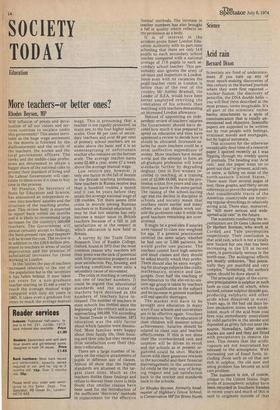Science
Acid rain
Bernard Dixon
Scientists are fond of understatement. If you turn up any of most epoch-making discoveries of this century in the learned 'journals where they were first reported — nuclear fission, the discovery of penicillin, the DNA double helix — YOU will find them described in the most prosaic terms imaginable. It's all part of the scientists' rather barmy attachment to a style of communication that is totally unemotional and objective. Scientific papers are supposed to be written not by real people with feelings, irrational moods and mortgages, but by logical automata.
That accounts for the otherwise inexplicably dour tone of a research paper I spotted recently as I was flipping through my weekly quota of journals. The heading was 'Acid rain,' and the paper went on to point out that "at present, acid rain, or snow, is falling on most of the north-eastern United States." There were then several pages of text, three graphs, and thirty-seven references to prove the simple point that considerable tracts of the American countryside are receiving regular drenchings in relatively strong acid. There may, moreover, be "still more serious and widespread acid rain" in the future.
The scientists conducting the inyestigation are Dr Gene Likens and Dr Herbert Borman, who work at Cornell and Yale universities respectively. Their conclusion is. that acid rain, which is not a totally new hazard but one that has been increasing in the US in recent years, is particularly serious in the north-east. The ecological effects are mostly unknown, "but potentially they are manifold and very complex." Something, the authors opine, should be done about it.
The principal origin of the corrosive precipitation is sulphur in such fuels as coal and oil which, When burned, release sulphur dioxide gas, producing sulphuric and other acids when dissolved in water. Years ago, in the bad old days before smokeless zones were established, much of the acid from coal fires was immediately neutralised by solid particles in the smoke and deposited as grimy fall-out near the source. Nowadays, taller smokestacks are used and they are fitted with precipitators to remove the soot. This means that the acidic vapours are not neutralised but released to the atmosphere. With increasing use of fossil fuels, including those such as oil that are rich in sulphur, the old soot and smog problem has become an acid rain problem.
The nuisance is not, of course, unique to the United States. High levels of atmospheric sulphur have been recorded in Southern Sweden in recent years and much of this is said to originate outside of that
Spectator July 6, 1974 country. The industrialised areas of Britain and the Ruhr Valley have been blamed for 'exporting' sulphur dioxide pollution to Sweden, and though the scale of this is debatable there seems little doubt that some transport of this sort (which is also facilitated by the use of higher chimney stacks) does occur. One recent investigation revealed that the acidity of rain in some parts of Scandinavia had increased more than 200-fold gince 1956.
Consequences of acid rainfall are both ecoqomic and ecological. Economically, erosion of buildings and other structures is slowly being recognised as a major problem. Damage to sculpture and other art forms is perhaps even more serious, being irreversible. One of the best known examples is the almost total destruction of sandstone figures at Herten Castle. Westphalia, due to the corrosive atmosphere of the Rhine-Ruhr industrial region.
Acid rain is also bad for living creatures, and has been blamed for fish kills — ,particularly of young salmonids — in Sandinavian rivers and lakes and Canadian lakes. Trees in the forests of northern New England and Scandinavia are also reported' to be growing more slowly than two decades ago, which is thought to be due to acid rain.
More stringent standards for sulphur emission, and the development of methods for generating 'clean' energy from oil and coal, will help to combat the menace. So will the increasing development of nuclear power. But Chat, of course, creates new difficulties altogether.
Dr Bernard Dixon is Editor of New Scientist and writes fortnightly in The Spectator



































 Previous page
Previous page